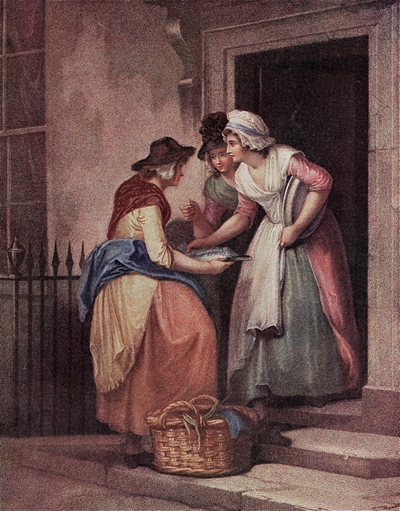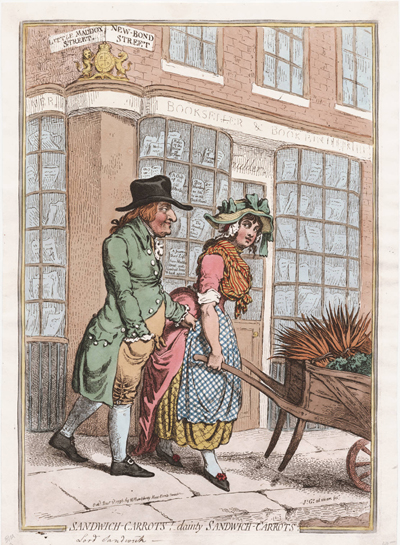Sandwich Carrots! Dainty Sandwich Carrots
Between 1792 and 1794, Francis Wheatley exhibited a series of popular paintings at the Royal Academy, entitled The Cries of London. The series featured somewhat idealized versions of the street vendors of London, each in a recognizable London setting, and each with his own unique cry including titles like "New Mackerel, New Mackerel", "Sweet China Oranges, Sweet China" and "Strawberrys, Scarlet Strawberrys". Prints of the individual Cries were available in both colored and uncolored versions as the series progressed.

New Mackerel, New Mackerel [1795]
© Spitalfields Life
Ever alert to the proceedings of the Royal Academy and to popular trends in the art world, Gillray's Sandwich Carrots! Dainty Sandwich Carrots is, I believe, Gillray's complex response to Wheatley's series. In keeping with many of Wheatley's Cries,, and the growing appetitle for prints of London topography, Gillray's Sandwich Carrots is a realistic depiction of a specific locale, the corner of Little Maddox Street and New Bond Street (within easy walking distance of Hannah Humphrey's print shop) where there was indeed a bookseller by the name of Faulder. The title of Gillray's print clearly mimicks the sing-song repetition of the vendor's cries and Wheatley's titles. And again like most of the examples in the Wheatley series, the focus is upon an interaction between the street vendor and a potential customer.

© Lewis Walpole Library, Yale University
But here things get more complicated. For the print is also a portrait caricature, or more accurately a portrait satire about a specific individual, the 5th Earl of Sandwich, whose reputation (brought out in other details in the print) distinctly changes our sense of what is being sold and bought.
John Montague, the 5th Earl of Sandwich, was a Tory Politician, serving as Master of the Buckhounds from 1783 to 1806. His father, the 4th Earl of Sandwich, was a notorious libertine and a member of the Order of Saint Francis, later known as the HellFire club, devoted to drinking, whoring, and mock religious and pornographic rituals. All of this is alluded to in the commentary provided by a series of fabricated book titles in the bookstore window, including "Rules of the Order of Sr Francis," "A Chip of the old Block," " a "List of Servant Maids," and "Doe Hunting an Ode by an old Buck Hound."
According to the commentary of Wright and Evans:
The scene represented here is said to have been one of the usual amusements of Lord Sandwich. A guinea was the usual mark of attention to the lucky flower-girl or itinerant barrow-woman, who attracted his glance.
Gillray is not so naive. The Earl's leering gaze, his outstretched left hand which seems rather to be grabbing the young women's apron rather than putting money in her pocket, both point to the sexually charged nature of this encounter—an old buckhound about to get his doe. That point is reinforced by the right hand of the Earl inserted in his pocket, a frequent suggestion in Gillray of sexual stimulation. (See, for instance, Quiz-zing a Filly.) But in an otherwise scrupulously accurate depiction of the Earl and his environment, Gillray has unaccountably blundered in his drawing of the Earl's right hand with its anatomically impossible fingers outside his pants. Or has he?
Gillray is notably unkind to older women who pretend to be younger than they are. But it is not so often noticed that he is equally critical of lecherous old men—men like Queensbury, the lecherous clerk in A Corner near the Bank, and Lord Sandwich here in this print. But this may be the unkindest cut of all, for the title Sandwich-carrots!-dainty Sandwich-carrots cannot refer to the carrots in the girl's barrow which are neither Sandwich carrots nor particularly dainty. But it may allude to other parts of the Sandwich anatomy.
Sources and Reading
- Commentary from the British Museum on Sandwich Carrots! Dainty Sandwich Carrots
- Draper Hill, Fashionable Contrasts, 1966, #74
- "John Montagu, 5th Earl of Sandwich," Wikipedia
- "John Montagu, 4th Earl of Sandwich," Wikipedia
- Thomas Wright and R.H. Evans, Historical and Descriptive Account of the Caricatures of James Gillray #427
Comments & Corrections
NOTE: Comments and/or corrections are always appreciated. To make that easier, I have included a form below that you can use. I promise never to share any of the info provided without your express permission.